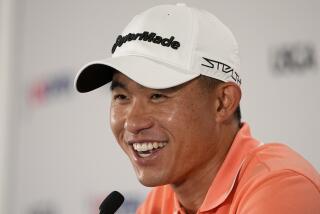FROM FAR AWAY COMES A RARE BIRD FROM SPAIN : Seldom Seen in U.S., Seve Ballesteros Nevertheless Has Admirers Here, Too
- Share via
SAN DIEGO — Seve Ballesteros has fought authority, and authority has always won. As a boy, he earned money as a caddie--30 cents a round--but he couldn’t keep his paws off the players’ clubs. One day he picked up a club and started swinging away, something caddies ought not to do.
The country club suspended him for a week.
So he was angry, he screamed a lot and he pouted. But it did no good.
And now it has happened again. The PGA made a rule in the early 1980s that forced foreign golfers to play in at least 15 American events if they wanted to be tour members. Seve--who is from Spain--agreed with the rule at first, but, he was getting homesick and overtaxed in America. In 1985, he played in only nine tournaments.
The PGA suspended him for a year.
So he was angry, he screamed a lot and he pouted. But it did no good.
The result is that we hardly ever see Seve anymore. He has won two Masters and two British Opens, and fellow pro Mac O’Grady says: “He’s as wonderful as Air Jordan, Dominique Wilkins and Spud Webb.” Still, he hardly plays in the United States. This year, he is allowed to play in America’s three majors--the Masters, the U.S. Open, the PGA--and in five other tournaments of his choice.
“I still think they (the PGA) are wrong,” he said, toning his protest down a bit from the days when he called PGA Commissioner Deane Beman “a little man who wants to be big.”
Regardless, what we have here is the greatest golfer you’ll never see. Severiano Ballesteros, approaching 30, is here only eight weekends a year, for goodness sake.
Two of those weekends are being spent in Southern California--at the Shearson Lehman Brothers Andy Williams Open that ended Sunday and at the L.A. Open that begins this week.
The Andy Williams Open was Ballesteros’ first competitive tournament in three months. Most of the time, he’s playing in the European PGA Tour, which is similar to its American counterpart except that the prize money is not as great.
There are many reasons why Ballesteros prefers playing in Europe. Primarily, it’s more convenient. His home is in Pedrena, a small village on the Bay of Santander on the northern coast of Spain. He can get to most European tournaments in an hour and a half and then head home. Besides, he has many friends in Europe. He made his fame there after winning the British Open, and he and West Germany’s Bernhard Langer are heroes and rivals--they are the Jack Nicklaus and Arnold Palmer of Europe.
As a result, corporate sponsors are all over Seve. He is paid to play in Europe--an estimated $30,000 a tournament--which isn’t allowed on the American tour.
“I don’t want to leave Europe,” he says. “For many reasons. I feel very comfortable there. I feel that, over the last 10 years, I help the European tour a lot. I feel I made my name over there, too. And I have many friends. And I have contracts. I have to play for the companies, you know.”
Ballesteros plays about 10 European tournaments a year, then leaves for four or five in Japan.
Japanese corporations such as Mizuno pay Ballesteros to play there. They throw nightly parties, which Seve admits are tiresome but necessary.
“Ballesteros is very popular, like a hero,” says Hiroshi Kuwahara of the Tokyo Sports Press. “When he comes over, he doesn’t just play the tournament, but also (made for) TV matches. Everything is given to him free. Plane fare and hotel rooms.”
John K. Wells, an interpreter for the traveling Japanese pros, says: “Nicklaus used to come over to Japan, and they’d give him a huge, huge hotel room. Like he was the president. Ballesteros gets the best hotels, too.”
This is how he makes his big money.
Friends estimate that Ballesteros’ yearly income is between $2 million and $3 million.
A boy following Ballesteros down the fairway speaks to Seve in Spanish: “Seve, como estas?”
“Bien,” Seve says.
The boy turns to his friend and says: “He answered me because I spoke Spanish to him. I hear he hates Americans!”
Seve says this is false. He doesn’t like to spend too much time here because he misses his family and friends.
“People have the wrong idea, I think. The thing is I have to play over there (in Europe). And, for me, it is very difficult to come over here, because it is a long way.”
Seve misses a short putt, turns to his caddie, and makes a vicious face.
A man in the gall e ry says: “It’s coming out of your paycheck, caddie.”
No, it’s not. Seve’s caddie is his older brother Vicente. Seve’s entire family is close, and his three brothers have all caddied for him at one time.
Seve, the youngest boy, says he learned golf by watching his brothers. Pedrena, his hometown was mostly poor, and the first “course” Seve ever played was the beach beside the Bay of Santander. He made his first golf club--he was seven at the time--from wood. His first golf balls were rocks.
Later, when he became a caddie, he says a member of the country club gave him a real golf club. He carried it everywhere. When he was 14, he was finally able to use the country club course. When he was 14, he also quit school.
When he was 16, he turned pro.
His father had been a farmer and a fisherman.
“We didn’t have a lot growing up,” Seve says. “Not really. Enough to eat, but no more than that. As I say, it was difficult.”
Seve is a private person and refuses to elaborate much on his personal life. He is getting married soon, according to O’Grady.
Of his interests, Seve said: “I like a lot of games. Tennis, Ping-Pong, biking, swimming, running. I watch TV in my spare time and I’m with friends and go to the movies. Everything that a normal person does.”
Adds his good friend, Kevin Iwankow: “Let me tell you, though, the players on the American tour are jealous of him. He has more talent in his little pinky than they have in their whole body. They’re a bunch of prima donnas. They haven’t learned the things he learned because they didn’t grow up poor and tough like he did.”
In between the 13th and 14th holes, Seve runs to a portable restroom.
A man says to his buddy: “You mean Seve Ballesteros goes to the bathroom?
A lot of people don’t think he’s human, including O’Grady.
“I’ll pay money to see two guys play golf,” O’Grady says. “Ballesteros and Greg Norman. If I were to rank them, I’d rate Ballesteros No. 1 and Norman No. 5, and nobody else would be in the top 10.”
O’Grady also says:
--”Every time Seve plays, he’s like Mike Tyson in the ring.”
--”He’s a modern-day Renaissance man, like a Da Vinci.”
--”I’ve learned so much from him that he’s helped me develop to the top echelon of the PGA Tour. I owe him a lot.”
Asked if other players on the tour shared his feelings, O’Grady said: “He’s probably more misunderstood than me. . . . Is he well-liked? Hmmm. Revered for his accomplishments? Yes. Liked for his social camaraderie? No. He’s quiet and private and a foreigner. Greg Norman is a foreigner, but Greg is gregarious. Because Seve lacks an outgoing side, they don’t think he has charisma.”
When Ballesteros finishes a round, he works on his game. He says he is a perfectionist. When he was a young golfer, he beat bushes with his clubs and cried himself to sleep when he played poorly.
But he has become a positive-thinker.
Asked once about his golf game, he said: “Better than yesterday, worse than tomorrow.”
A reporter turns to a PGA official and asks: “Think I can get a one-on-one interview with Seve?”
The PGA official says: “A one-on-one? That would be like calling the White House and asking Ronnie to stop by.” Seve conducts his one-on-one interviews on his way to the driving range.
He doesn’t trust American sportswriters.
“I say many things you (media) people take in the wrong way,” he says. “Last year at the Masters, when I was in the press room, I say: ‘I come to play the Masters and I came to win.’ Everybody comes to win. But, the next morning, it appeared in the paper that Seve says the Masters is his. I never say that. That’s really hard on me.”
He can be abrasive, however. After he put a shot in the rough at the Andy Williams, a newspaper photographer came close to shoot a picture.
“Get back,” Ballesteros said.
The photographer did get back, behind a tree, and Seve said: “Move up the hill some.”
The photographer said: “Want me to move the tree, too.”
A man and his wife can’t decide whether they want to follow Ballesteros for all 18 holes.
The man says: “There’s Ray Floyd. Let’s watch him.... Nah, on second thought, I’d rather watch Steve Ballesteros.” No, it’s Seve, not Steve. S-E-V-E. But then, what else could we expect? He’s here only eight weekends a year, for goodness sake.
More to Read
Go beyond the scoreboard
Get the latest on L.A.'s teams in the daily Sports Report newsletter.
You may occasionally receive promotional content from the Los Angeles Times.










